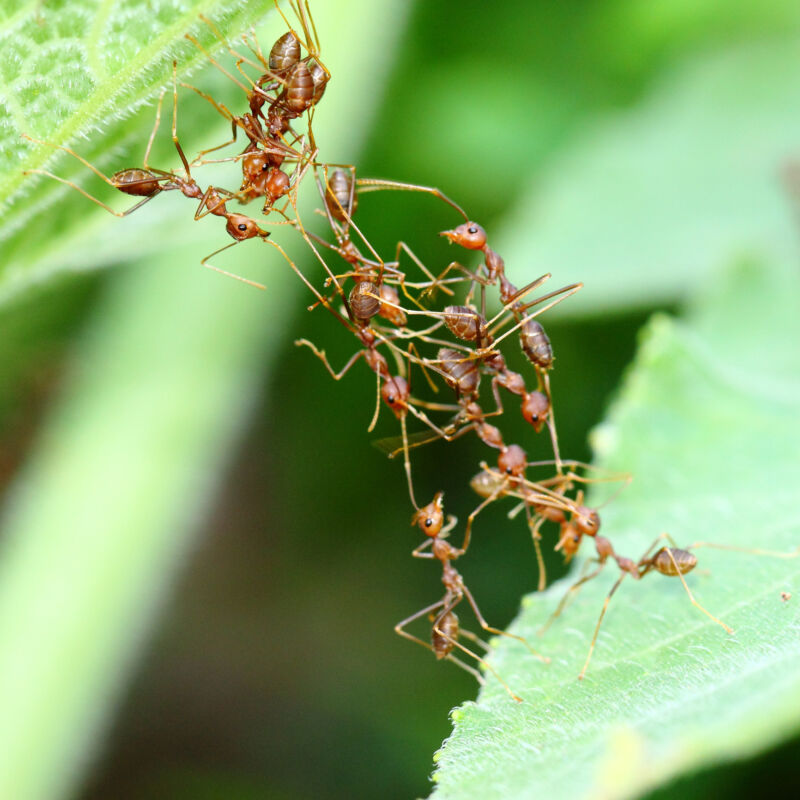
Social insects, which do not have a very large nervous system, are capable of remarkably sophisticated behaviors, such as the directional dance of bees or the life-saving rafts formed by fire ants. In these cases, the benefits of this behavior – more food or survival, respectively – are quite obvious. But there are also cases where the benefits aren’t so obvious, so how do insects collectively decide to engage in a risky activity?
Researchers are studying a species of ant, the weaver ant Oecophylla smaragdina, who can move vertically between trees by building a ladder using his own body. The effort takes many workers away from foraging as long as the ladder is in place, making it a major investment. But in most cases the rewards will be uncertain; there is only a payout if the ants find an important food source on the newly entered level.
To make the decision, ants seem to judge the distance between their location and the destination. But not every ant makes the same judgment, and it is possible to trick the ants into building longer ladders by moving the destination.
Take a gamble
Most people find risk/reward decisions difficult – you only have to look at things like cryptocurrency or NFTs to see that we are often wrong. But weaver ants must somehow collectively make that evaluation. In their natural environment, they regularly build ladders that allow them to climb up into the canopy they call home. Those ladders require the commitment of a significant number of workers as long as they remain in place.
And the ants form them with uncertain payoff. Until they explore their newly accessible destination, there’s no way to tell if there’s enough food to make the risk pay off. “This makes chaining look like a gamble,” the authors of a new paper write. “The colony must invest part of its capital (number of ants) to perform a task with unknown results.”
To understand the decision-making process, the researchers used video recordings to track the ants’ behavior as they built a ladder. Their system involved giving the ants access to a horizontal bar. A height-adjustable platform could be placed under the bar to provide a destination, and a food source was placed at the end of the platform, as a reward for building a bridge between the bar and the platform.
Although the ladders are a few ants wide, the researchers found that nearly half of the ants that participated in the process did so at the far end of the growing chain. The tip is also where about 90 percent of the ants left the chain, which helps keep the whole thing stable rather than collapsing from internal instability. Once an ant attaches itself to the chain, it simply clings to its neighbors and stops moving and stays that way unless the tip of the ladder retracts.
Once the ladder is close to the platform, the ants that arrive at the tip start reaching for the platform, eventually completing the connection.
Go the distance
Using data from video recordings, the researchers showed that the process wasn’t really influenced by most of the things that could potentially affect successfully growing a ladder. Whether or not the ants that reached the tip got into the chain does not seem to be related to the length or the distance from the tip to the platform. Instead, ants seemed to spend more time in the chain when the platform was close.
That explains the growth of successful chains, but not their initiation. Here, the main determining factor was the distance between the bar the ants started on and the destination platform. If the two were 4 inches (11 cm) or more apart, the ants never built a ladder across the distance.
But things were a bit more complicated than a yes/no decision. Even when the distance was so great that the ants didn’t finish a ladder, there were always a handful of ants trying to start one at the bottom of the rod. They just couldn’t get many of their peers to participate. This suggests that there is at least some diversity in ant behavior.
The researchers also found they could prompt the ants to build longer ladders by using a movable platform. They could start the distance within the range ants would normally cover and keep moving the platform down to keep the tip within that range. That suggests that the ants don’t decide whether to build a ladder until they’re at the tip of a growing ladder.
Overall, the results suggest that a complex behavior can be built up from several simpler behaviors. For example, there seem to be different behaviors involved in starting, joining, and staying within a growing ladder. And the most important risk/reward decision is how far the destination is when an ant is ready to get up that ladder. That distance is probably a pretty reasonable measure of how many of the colony’s workers will eventually give up their productive labor to make it through the ladder.
PNAS, 2023. DOI: 10.1073/pnas.2216217120 (About DOIs).

